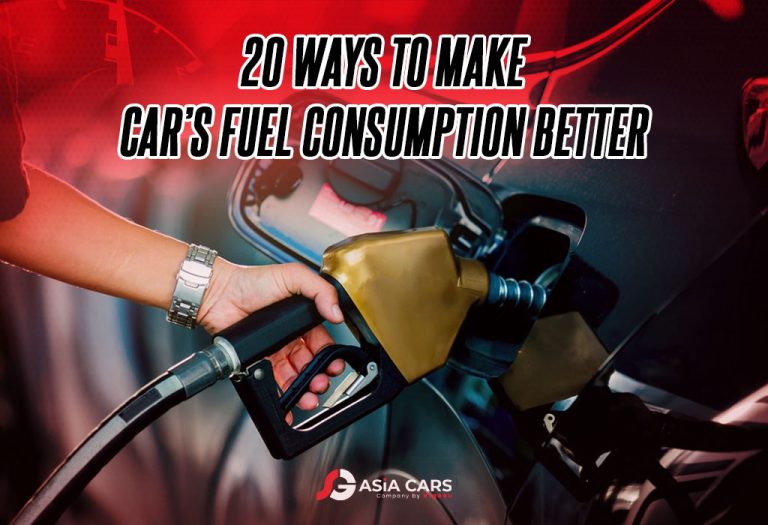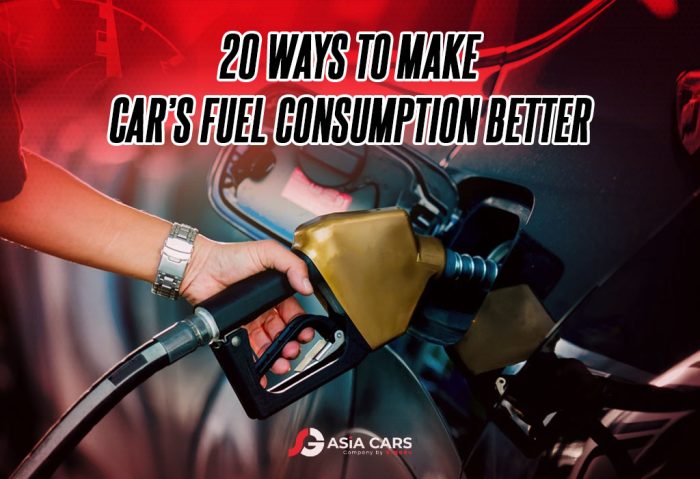
20 Ways To Make Car Fuel Consumption Better

If you’re concerned about the price of gas or want to reduce the impact of your vehicle on the earth, There’s no reason to part with your car to purchase the latest hybrid vehicle or even an econobox that is small and compact.
Do you know that cars can use up to 30% more fuel when maintenance isn’t performed regularly? We all recognize the importance of regular maintenance for our vehicles; however, due to many reasons, we don’t make enough time to complete routine maintenance enough.
I get more questions regarding fuel efficiency than on any other topic. If you do not want to be a “hyper-miler,” these tips will help you make the most out of each drop of fuel you pump into your tank.
- Check your tire pressure every month at a minimum. Tires that are not adequately inflated will use more significant fuel. If the tires weigh more than eight pounds or less when raised (not a common occurrence), the resistance roll of the tires is increased by five percent.
- When pumping, ensure your hose remains inside it until the pump shuts off. Be sure to allow all the fuel out of the nozzle. A quarter of a cup can flow from the hose. You bought it.
- When appropriate, make use of the cruise control. This could help you save about 6 percent of the fuel you burn on the road.
- Corroded battery cables enable the alternator to perform better and consume much more energy. Clean them regularly each time you conduct an engine inspection.
- Don’t let the car idle for more than 1 minute. It uses between one and a half gallons of fuel every hour, which is a waste of CO2 in the atmosphere. Modern engines use less energy by turning off and restarting for extended durations of time. It’s already a reality that there are zero idle areas. To efficiently start an engine, you have to drive it but not accelerate it. Engines are most efficient when they’re stressed and can warm up faster if you start the engine, keep it open for 20 minutes (this raises the pressure of the oil), and then let it go.
- Change the air filter at the least number of times as stated in the owner’s manual, More often when it is dusty.
- Have a regular engine inspection. Since the introduction of computer-controlled fuel injection, there’s no reason to use a traditional “tune-up” anymore. In the best case, fixing ignition plugs, oxygen sensors, and air and fuel filters will be necessary.
- If your car was manufactured before the mid-1980s, you will likely have an oxygen sensor within your exhaust system. It’s best to replace it with spark plugs, following the specifications provided by the manufacturer. This tiny device can reduce the flow of fuel and significantly impact the performance of the energy.
- In the highest gear, without needing to run the engine, is an excellent method of driving. When driving at 60 km/h, the vehicle burns 25 percent more fuel in the third gear than in the fifth. Fast driving in lower gears may consume 45 percent of the energy needed. If you’re running a trip computer in your car, it’s likely to have an “Instant fuel economy” setting. Make sure to check this gauge frequently and maintain the number of liters per 100 kilometers to an acceptable level. The car manufacturers have turned this into an exercise. The fresh Ford Fusion Hybrid has an awe-inspiring visual display and releases every when you reach the threshold of efficiency in fuel consumption. I was fortunate enough to drive the car, and each time we went into the driveway, my son would inquire, “How many leaves on the tree, Dad”?
- Take your time and move with ease. With an easy throttle and avoiding the use of heavy and abrasive braking, you’ll be able to reduce the amount of fuel you use and wear and wear and tear. Research suggests that driving habits can impact fuel efficiency by 30 percent.
- Reduce your weight. Make a list of things you’ll require for your trip. If you don’t require anything, don’t bring it. Please remove roof racks when they are not needed because they could create drag on the wind: the more weight you carry and the less weight, the lower fuel emissions, and consumption. An increase of 100 pounds within the trunk reduces the efficiency of an automobile by around 1 to 2. The additional weight you carry around is a waste of fuel.
- Select the appropriate gasoline octane to match your car. Check out the owner’s manual to figure out the right octane for your vehicle. Octane ratings measure the capacity of gasoline to reduce the sound of an engine. The higher the octane rating is more excellent, the more it is. Six percent of cars sold need premium gasoline. However, premium gasoline is about 10% of the gasoline available. Take care not to fall for the urge to buy premium gasoline with more octane to get “premium” performance.
- Combining errands into one trip will save time and cost. Short trips in cold weather could require twice as much fuel as a multi-purpose trip that covers the same distance when the engine is at an appropriate temperature. Planning your journey will ensure that it is finished when the engine is hot and running efficiently.
- You can increase the efficiency of your vehicle by one-to-two cents when you use the grade recommended by the company that makes motor oils. For example, using 10W-30 motor oils in an engine designed to run on 5W-30 can reduce fuel efficiency by approximately 2 percent. It also becomes harder to fill and causes a loss of horsepower within the parasite.
- Do not “rev” the engine, especially before turning off your engine. It wastes fuel and can also wash oil from the cylinder’s walls. It’s not an option for your next attempt to start the engine since the cylinder walls are more likely to dry.
- Be sure to drive steadily. Your speed at or lower will waste fuel. Be wary of tailgating. It’s risky, but it can also affect your financial situation if a motorist suddenly slows.
- Do not rest your left foot on the brake pedal while traveling. A slight pressure could cause “mechanical drag” on components that wear them out prematurely. That “dragging” can also require more fuel to counteract any drag.
- Avoid driving on rough roads as often as feasible, as dirt and gravel may take away 30% of your fuel. Every time the wheels turn between a vertical and horizontal plane, the automobile removes the energy needed for forwarding motion. Expressing this is to drive along”the “washboard” road. It’s not only uncomfortable; however, the vehicle slows down due to the transfer of energy – even if you think that physics courses would not be useful soon, the driver is forced to accelerate faster, wasting fuel.
- Inspect the suspension and components of the chassis to determine any signs of misalignment. Axles, shocks, or wheels that are worn out along with broken springs can cause an increase in drag to the drivetrain and the risky circumstances they can create.
- SUV owners should be thinking about changing from a slick off-road tread pattern to a more efficient road tread.
These are my thoughts and my responses to a range of questions about the efficiency of fuel. I’m sure you’ve got your thoughts, and I’d suggest that everyone who reads this article post their thoughts in the comment section of the article. Yes, this is for those who are ultra-milers as well.
Do we think we will ever match Europeans’ desire for small luxury cars? The price of fuel will decide the outcome. If they are at the levels, they currently are or decrease, then the move to smaller vehicles with European origins could result in a sour choice.
